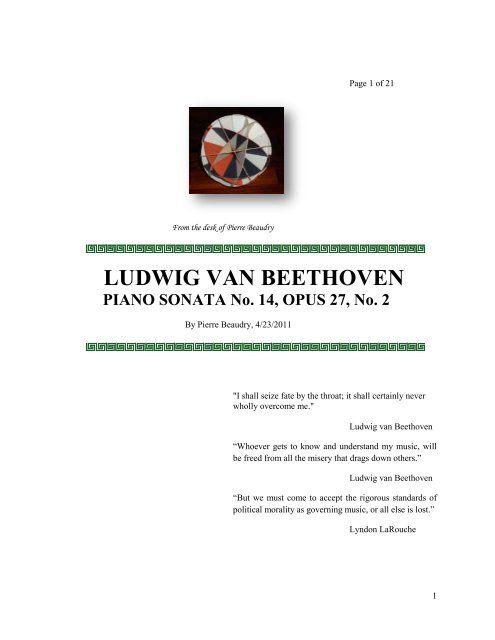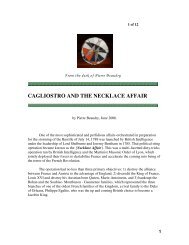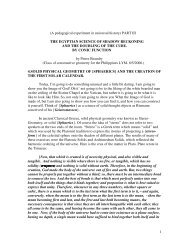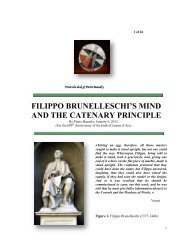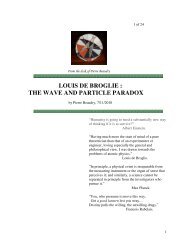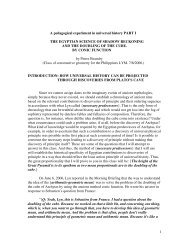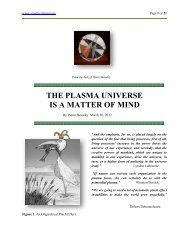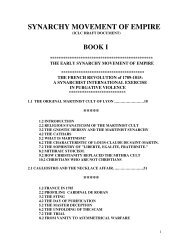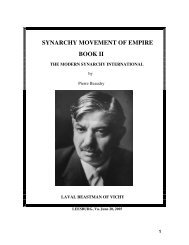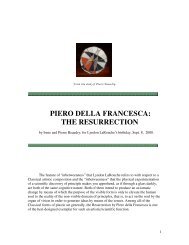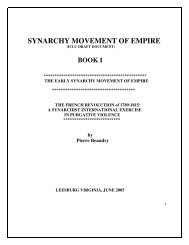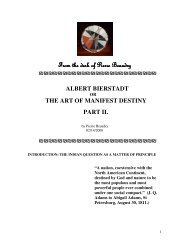BEETHOVEN SONATA OPUS 27, NO. 2.pdf - Pierre Beaudry's ...
BEETHOVEN SONATA OPUS 27, NO. 2.pdf - Pierre Beaudry's ...
BEETHOVEN SONATA OPUS 27, NO. 2.pdf - Pierre Beaudry's ...
You also want an ePaper? Increase the reach of your titles
YUMPU automatically turns print PDFs into web optimized ePapers that Google loves.
Page 1 of 21<br />
From the desk of <strong>Pierre</strong> Beaudry<br />
LUDWIG VAN <strong>BEETHOVEN</strong><br />
PIA<strong>NO</strong> <strong>SONATA</strong> No. 14, <strong>OPUS</strong> <strong>27</strong>, No. 2<br />
By <strong>Pierre</strong> Beaudry, 4/23/2011<br />
"I shall seize fate by the throat; it shall certainly never<br />
wholly overcome me."<br />
Ludwig van Beethoven<br />
“Whoever gets to know and understand my music, will<br />
be freed from all the misery that drags down others.”<br />
Ludwig van Beethoven<br />
“But we must come to accept the rigorous standards of<br />
political morality as governing music, or all else is lost.”<br />
Lyndon LaRouche<br />
1
INTRODUCTION<br />
What human beings have been able to accomplish in the past ten thousand years in terms of<br />
demonstrating their ability to survive, as a species, is nothing in comparison with what they are going to<br />
have to come up with, now, in order to survive the current 62 million year cycle of galactic change that<br />
the solar system is currently going through. This is not merely a scare tactic; this is a real threat. No use<br />
complaining about this fact, because it’s too late. The Sun has already begun to move north of the galactic<br />
plane, and you cannot change that. So, you might ask: “What are we going to do? How are we going to<br />
protect ourselves?”<br />
As Lyn replied during his last webcast, you may not know where you are going to end up, but<br />
you can discover how to get there. Mankind knows what direction to take. All it has to do is to take the<br />
moral step to face it and sit will be solved. As Lyn said, we don’t know if mankind will succeed or not,<br />
because we don’t know if humanity will have the moral fitness to survive, but we know that man is<br />
equipped to succeed, because the last ten thousand years have shown us how it is in man’s nature to<br />
discover ways to accomplish axiomatic changes in his own way of thinking, and that such axiomatic<br />
changes also apply the physical universe as a whole. That is why we must study and learn to play<br />
Beethoven’s music, because he is one of the greatest creative human minds ever to discover which<br />
direction to take.<br />
However, before going into Beethoven’s creative work, one thing has to be made clear: the crisis<br />
that the solar system has currently entered into does not simply happen to coincide with the moral and<br />
financial crisis that humanity is currently going through. The crisis is the same. The galactic crisis is the<br />
same as the human crisis; because both the Galaxy and humanity have the same fundamental creative<br />
characteristics and they both require the same solution. It is the same crisis, also, because man’s crisis is<br />
being subsumed by the galactic crisis of the solar system.<br />
1. THE <strong>BEETHOVEN</strong> PRINCIPLE OF AGAPE.<br />
When Andras Schiff gave his series of master classes on the subject of Beethoven’s 32 sonatas,<br />
he demonstrated how the 1801 Sonata in C-sharp minor was the most misunderstood of all of<br />
Beethoven’s sonatas. There is like a “thick layer of false tradition on it, …” he said, “… and the music is<br />
like a great painting that has a lot of dust on it, and a lot of dirt, and you want to restore it, so you can get<br />
to the real colors.” In a way, this report on Beethoven’s Sonata No. 14 in C-sharp minor is an attempt at<br />
uncovering the underlying principle that lay dormant underneath this romantic filth, and which has been<br />
kept hidden for over 200 years.<br />
First, let’s get rid of the first coat of fake varnish that it was covered with, since 1836, when the<br />
critic, Ludwig Rellstab, gave it the insane identification of “Moonlight Sonata.” This fallacy imposed on<br />
2
the composition was as shallow as the public opinion oriented mind of the critic who fabricated it.<br />
Unfortunately, the dirt stuck and musicians have been misled about the true meaning of the sonata, ever<br />
since. Therefore, it is high time to clean up this defilement for the sake of generations to come and to<br />
restore the truth of its principle once and for all. The truth of the matter is that this sonata was composed<br />
as an expression of the sublime love of creativity, as opposed to the romantic vagaries of pleasure and<br />
pain. If one is to understand Classical artistic composition at all, it is going to be through a Promethean<br />
victory of agape over eros that one must look for in this Beethoven composition. Moreover, it is not by<br />
accident that Beethoven’s The Creatures of Prometheus was also written in 1801.<br />
Beethoven left several crucial notes in his manuscripts establishing his clear intention about this<br />
sonata. According to these notes, Beethoven composed the first movement of his sonata as a funeral<br />
memorial in honor of Mozart’s Don Giovanni. The notes refer to the specific section right after Don<br />
Giovanni stabbed the Commendatore to death. The sonata replicates the same ostinato triplets that<br />
Mozart used to express the death-throes of the Commendatore. This homage was, as I will now show,<br />
Beethoven’s way of celebrating the great Lydian revolution that Mozart had made from the original<br />
seminal revolutions of Bach and Haydn. This is the message that Beethoven was delivering to Countess<br />
Giulietta Guicciardi, when he dedicated the Sonata No. 14 to her. On July 6, 1801, Beethoven wrote to<br />
her saying: “O God – so near! So Far! Our love, is it not a true heavenly edifice, firm as heaven’s vault?”<br />
Figure 1. Beethoven’s Sonata quasi una fantasia No. 14, Opus <strong>27</strong>, No. 2. The opening measures. Note<br />
the Neapolitan modulation in the third measure.<br />
At the opening measures of the first movement (Figure 1.), Beethoven noted: “Adagio sostenuto.<br />
Si deve suonare tutto questo pezzo delicatessimamente e senza sordini” (Slow and sustained. One must<br />
play this whole movement with great delicacy and without dampers), that is to say, with sustained pedals<br />
on modern pianos, in order to maintain a continuous flow of the musical ideas. Furthermore, if this<br />
movement is to be understood as a motivführung expression of the sublime, then, it should not be played<br />
slowly, like it is usually played. The point is that the piano must express the dynamic tension between the<br />
3
fear of individual death and the yearning for participation in the immortality of mankind. This is the<br />
paradoxical tension that must be maintained throughout the piece.<br />
However, such an elementary musical idea reflecting a meditative throbbing pain is very difficult<br />
to play properly on the keyboard, because it must also contain within it, as its substance, the Lydian effect<br />
of its ordering principle of change. In other words, the last throes of a dying man, must express the<br />
continuous process of change through which new ideas will be generated. The paradox is that the dying<br />
man is attempting to stop the process of dying and is yearning for immortality at the same time. During<br />
those dying moments, the Commendatore sings: “Now the pains of death invade me. From my breast my<br />
soul is soaring …” The Beethoven note is explicit about the transposition of the Mozart ostinato triplets<br />
in C-sharp minor referring to the lancinations of the dying Commendatore. It is also expressing the tragic<br />
lancinating pains of “Mille tre” that Don Giovanni’s perversions are causing throughout the land. This, of<br />
course, correlates with the throbbing pains of Beethoven’s own state of mind, at the time when he is<br />
losing his faculty of hearing. Once this relationship between Mozart’s moral outrage and Beethoven’s<br />
hearing condition is understood, you can no longer make the case of a romantic moonlight fantasy on the<br />
shores of Lac Lucerne. Here is the Mozart section of Don Giovanni that Beethoven derived his musical<br />
idea from. (Figure 2.)<br />
Figure 2. Mozart’s Don Giovanni. Measures 186-189 mark the ostinato triplets of the Commendatore’s<br />
lancinating throbs after he has been wounded mortally by Don Giovanni. Note the singing phrase of the<br />
Commendatore: “sento l’anima partir…” (I feel my soul leaving…) and, simultaneously, Leporello<br />
4
singing: “palpitar il cor mi sento.” (I feel his heart palpitating), and Don Giovanni who sings:<br />
“palpitante veggo l’anima partir” (through the lancinations, I see his soul leaving.) Thus, the perfect<br />
confusion of three different sense-perceptions.<br />
(Report here on the three manuscript notes published by Enrich Schenker.)<br />
Here, Mozart played on the sensitive ambiguity between the pulse of the body and the pulsating<br />
of the musical triplet idea. However, the point is not simply the internalization of the death throes of a<br />
dying man, but also the fact that this man is singing the swan song to his own body, as Beethoven is doing<br />
with his hearing. He is telling his body that his soul is leaving it behind in order to soar into immortality.<br />
That’s the common agapic quality that the two creative minds of Mozart and Beethoven are sharing in.<br />
However, Beethoven takes it a step further. There is a crucial change, here, that Beethoven is<br />
stressing with great emphasis, and which can only be expressed as the delicate flow of the motion of a<br />
singularity passing continuously from life into death, and then, into immortality, delicatessimamente, as<br />
if in a phase change relationship which must take place in the great discontinuity between two<br />
axiomatically different moments of change. The flow, however, must be expressed as an extended<br />
continuity of change, without percussiveness, and in a way where the continuum of change reflects<br />
causality Adagio sostenuto. It was the condition of his deafness that forced those ideas of axiomatic<br />
change on Beethoven, and that had gripped all of his waking moments; the inevitable disease that crippled<br />
him and the hope to cure it was transformed into the impossible tension between an inaccessible ideal and<br />
the desire to attain it. This is why this sonata is so difficult to play.<br />
Like Andreas Schiff reported, the whole first movement is strange because it is like a funeral<br />
theme where all of the intervals strengthen one another in such a manner that all percussive relationships<br />
are excluded and no breaks must be sensed within the entire movement between the elements and the<br />
process that cause the element to change: the discontinuity must be continuous, as in the Leibnizian<br />
principle of continuity. In other words, this Sonata is not like any other Sonata. It is a musical revolution<br />
in the sense that its method of composition pertains to universal physical principles.<br />
As Schiff put it, dynamically, everything must be “played pianissimo (very softly), almost like a<br />
Bach Prelude!” Remember how Gounod’s Ave Maria had transformed Bach’s first Prelude into a painful<br />
funeral memorial, for his deceased friends, Felix and Fanny Mendelssohn; that is the same idea with<br />
Beethoven, except without emphasizing the effect of the discontinuity that Gounod introduced at the end.<br />
Only the Lydian tension must be maintained throughout, and then released at the appropriate moment.<br />
The first movement is not a traditional sonata movement, but an introduction to something that is<br />
completely new, a sort of prelude to the creation of a new world. On the other hand, the second movement<br />
is a brief joyful break, while the third is a furious stormy creative process.<br />
5
2. THE LYDIAN MEASURE OF CHANGE.<br />
“Let Lydian intervals be the wines that fill the cup of<br />
your soul.”<br />
Dehors Debonneheure<br />
The very first measures of the sonata establish the tonality of a single voice for the duration of the<br />
entire movement, the voice of lamentation with repetitive quadruple series of triplets, in the right hand,<br />
which define the ostinato (obstinate) characteristic of a lancinating pain, accompanied by octaves in the<br />
left had, and using the Neapolitan to modulate the lamentation by semitones. That is the first clue that<br />
Beethoven gave as an indication for the mood orientation of the sonata. The rhythm has to be as regular as<br />
a throbbing pain, but not as fast as heart beats. The process is an almost exact replica of how Mozart<br />
wrote the score to express the dying moments of the Commendatore, except that Beethoven is leading the<br />
listener toward a deliberate dissonance, which is so obvious that pianists generally avoid, because they<br />
think it is a mistake. There are two such dissonances in the first movement; they are at measures 16 to 18<br />
and 52 to 54. (See figure 3.)<br />
Figure 3. The two dissonances of C#-D, and C-C# rotating around C#.<br />
Unless this deliberate dissonance is understood and appropriately stressed, the pianist doesn’t<br />
know what he is doing, and the entire piece is misunderstood and botched. Those two dissonances are the<br />
key to the entire sonata. The entire movement is uniquely pivoting around the two painful intervals<br />
between Bb-B-C in the first case, and C-C#-D in the second case. The reason for this is simple: this is<br />
6
where the key signatures of C sharp minor and D flat major are decided from the ordering principle of the<br />
Lydian modality. It is the expansion of these double dissonant singularities that Beethoven used to solve<br />
the excruciating paradox he had to solve. Technically speaking, this means that E, G, Bb, C# resolve into<br />
D flat major, and Eb, F#, A, C, resolve into C sharp minor. There you have it in a nutshell.<br />
Therefore, this singularity must be present persistently in the mind of the interpreter, like a<br />
painful sore that is conveyed as if from the inside of the modulating voice of the triplets. The dissonances<br />
are within those Lydian clusters, not outside of them. This is the reason why the elliptic wave of the torus<br />
is a better representation of the Lydian divisions of the octave than the conical spiral action, because their<br />
values are everywhere the same, and their inversions do not change those values in any way.<br />
Here, Beethoven is forcing the listener to stretch his mind to the point that he has no choice but to<br />
discover the truth of some painful experience through the two dissonances of C#-D and C-C#, and then<br />
look for the reason why he chose the Lydian interval of the left hand to temper them. This sort of pain<br />
relief is the only way to make such an anomaly a lawful and necessary moral event in music. Similarly,<br />
the triplet intervals are intentionally written to express the same form of pain relief lawfulness, but not<br />
with the same tension, and thus, they vary in their repetitive intensities until they reach a point where the<br />
funeral March type of dotted rhythms, tum-to-tum, confirm that you must remain in that repetitive mode<br />
of lancinating dissonant tensions, not knowing where you are going to end up, until those tensions reach a<br />
transformation point where two Lydian wave clusters take over the process completely. Then, and only<br />
then, are you able to realize what Beethoven wanted you to discover.<br />
So, the tension of the whole process builds up to that climax where the lancinating triplets are<br />
transformed, by an almost imperceptible series of extended inversions, into two wave series of complete<br />
Lydian clusters. Their notation is still in triplets, but now, they are releasing explicitly the emotional<br />
effects that they had been charged with and which had been building up inside of the entire process from<br />
the beginning, like the shaping of an explosive charge that had been set to trigger a great explosion. But,<br />
the explosion does not take place here. They are just precursors of an explosion to come later. This is why<br />
Beethoven chose the tonality of C-sharp minor. No other key could have such a powerful emotional<br />
warning effect.<br />
7
Figure 4. First movement, Sonata quasi una fantasia, Opus <strong>27</strong>, No. 2. The two series of Lydian<br />
clusters, measures 32, and 34 to 37, which have been underlying the ostinato triplet lancinations from the<br />
beginning.<br />
Next, study attentively this middle section (Figure 4.) of ascending and descending series of<br />
Lydian waves, which musicians identify simply as diminished sevenths without any other consideration.<br />
What foolishness. Be aware of the danger of falling into the trap of using diminished sevenths simply for<br />
jazzy effects, as the current degenerate culture does. There is much more to it than meets the ear. What is<br />
hidden in the Lydian clusters is precisely the moral principle that Beethoven released as the detonator of a<br />
great explosive agapic passion for creativity in the third movement. Beethoven is showing us that such<br />
Lydian measures of change can be as quiet and delicate as they can become explosive. The explosive<br />
charge, however, will not be released in the first movement. That is the key to the actual resolution of the<br />
whole process of this sonata, the key to understanding the crucial relationship of the first and the third<br />
movements.<br />
So, midway inside of the first movement, the Lydian clusters that determined the key signatures<br />
of the three movements of the entire sonata is given to the listener, and from that moment on, he must<br />
take these Lydian elliptical waves into consideration, and hear them resonate throughout the rest of the<br />
8
composition. Why is this important to note? Because this is where the extraordinary lack of melody of the<br />
first movement forces you to turn to counterpoint for some solace, and forces you to rely on those<br />
modular waves as a memory function. These Lydian clusters also need to be played as triplets and as<br />
actual conscious generative quasi-inversions of the entire movement. It is because most musicians do not<br />
understand this Lydian agapic mood that they generally play this movement too slow, and in a syrupy<br />
romantic manner. In so doing, they completely miss the motivführung unity of effect of Beethoven’s<br />
agapic principle of composition.<br />
I cannot emphasize enough the importance of these Lydian wave clusters, because the entire<br />
sonata is held together by their counterpoint. This was the most revolutionary aspect of counterpoint<br />
coming out of Bach, Haydn, and Mozart; and this is what sealed their common motivführung affinity<br />
with Beethoven. This is the process that made Beethoven most happy at that dark period of his difficult<br />
life, especially when he realized with horror that he was going to become permanently deaf.<br />
The way to look at those Lydian clusters of minor thirds, therefore, is to look at them as Plato<br />
looked at generating agapic mean proportionality; that is to say, in a manner such that one cannot be<br />
generated without the support of another; the first creating a second, and the second generating a third<br />
which, in turn, is what gave birth to the first. Thus, all three clusters are so intertwined among each other<br />
that they are all means of one another, and, therefore, they are all come to be one. Note, at this point, that<br />
Beethoven has used only two of those three well-tempered Lydian elliptical wave functions. Where is the<br />
third one?<br />
Figure 5. (a) The “Lydian” interval. (b) Leading tone F# - G in the key of G major/G minor. (c)<br />
Possible Lydian intervals in the Well-tempered system.<br />
9
“The Lydian interval is the only interval which cannot be generated by the principle of inversion<br />
of complementary intervals within any given key. This interval uniquely divides the octave exactly in<br />
half: that is, the interval from the tonic to the Lydian tone is the same amount of change as the interval<br />
from the Lydian tone to the octave. In the key of C major/minor, for example, this corresponds to the<br />
interval between C and F♯, which also corresponds to the physical singularity of the register breaks in<br />
the soprano and tenor singing voice [Figure 5(a)]. (above)<br />
“Divide an octave in half. This generates a Lydian interval. In the major/minor mode, the Lydian<br />
interval is a dissonance with respect to any given key. For example, in the key of C major/minor, the<br />
interval C-F♯ is such a dissonance. Yet this Lydian interval has the unique property of being a pathway<br />
from one key to the next, by way of the leading tone of that next key (F♯-G in the key of<br />
G major/G minor) [Figure 5(b)]. It is a type of singularity to be resolved through the development of the<br />
composition.<br />
“When the octave is divided in half again, two Lydian intervals are created. There are only three<br />
such combinations possible in the well-tempered system [Figure 5(c)]. (above)” (Bruce Director, What<br />
Mathematics Can Learn from Classical Music, Fidelio Magazine, Winter 1994.)<br />
3. THE GOVERNING MORAL PRINCIPLE OF MUSIC<br />
As Beethoven wrote to his dearest friend Carl Amanda on July 1, 1801: “A sad resignation must<br />
be my refuge, although, indeed, I am resolved to rise above every obstacle.” (Beethoven letter to Amanda,<br />
July 1, 1801 in Op. Cit, p. 282.) This, without a doubt, was the time when Beethoven had no choice but to<br />
settle his account with the domain of sense perception and consecrate the rest of his life to the domain of<br />
musical ideas. It was not an easy decision to make. As his so-called Heiligenstadt Testament of 1802,<br />
attests, the year when he composed this sonata was THE turning point in his life, because he knew he was<br />
becoming completely deaf. Again, the singularity, better still the paradox, was the absolute tension<br />
between something that was inevitable and the relentless urge to obey his destiny. As he wrote in his<br />
testament:<br />
“But, what a humiliation for me when someone standing next to me heard a flute in the<br />
distance and I heard nothing, or someone heard a shepherd singing and again, I heard nothing.<br />
Such incidents drove me almost to despair, a little more of that and I would have ended my life –<br />
it was only my art that held me back. Ah, it seemed to me impossible to leave the world until I<br />
had brought forth all that I felt was within me. So, I endured this wretched existence”… “Divine<br />
One, thou seest my inmost soul, thou knowest that therein dwells the love of mankind and the<br />
desire to do good. – Oh fellow men, when at some point you read this, consider that you have<br />
done me an injustice; someone who has had misfortune may console himself to find a similar case<br />
10
to this, who despite all the limitations of Nature, nevertheless, did everything within his power to<br />
become accepted among worthy artists and men.” (Op. Cit., p. 305)<br />
This was the principle, as he exposed it in his last will and testament. Although the letter was<br />
written to his two brothers, it was never delivered to them. In reality, he had written it for the future<br />
generations. In that sense, however painful it must have been for him to accept his infirmity, his<br />
resignation before the fact that he would not become a virtuoso, or a famous conductor might have been a<br />
God sent gift to humanity. As he wrote: “Necessity compels him owing to others to think and to work for<br />
others.” This is what led Beethoven’s biographer, Alexander Wheelock Thayer, to raise the terrible<br />
question: “Who can say that the world has not been a gainer by the misfortune which stirred the<br />
profoundest depths of his being and compelled the concentration of all his powers into one direction?”<br />
(Thayer’s Life of <strong>BEETHOVEN</strong>, revised and edited by Elliot Forbes, Princeton University Press,<br />
Princeton New Jersey, 1973, p. 282.)<br />
These are the historically specific conditions under which it can be said with a fair amount of<br />
certainty that during the short period of 1800-01, Beethoven made one of the greatest breakthroughs in<br />
Classical artistic composition by writing the Sonata quasi una fantasia.<br />
[[[[I was reminded recently about Lyn’s Memorandum on Truth is Beauty, and Beauty is Truth:<br />
Understanding the Science of Music, September 1986?… and the double-connectedness of the musical<br />
scale that Lyn referenced in that piece with respect to the science of music, especially to Abelian-<br />
Riemannian functions. (Quote from Lyn on Truth is Beauty…]]]]<br />
People have a wrong sense of what change is, because they think of change as movement. That is<br />
the wrong way to look at change. You don’t look at change as the motion of a man going around the<br />
block, or of a woman changing the baby’s diaper. No, change means transformation, that is, the<br />
transformation of something that becomes something completely different, like a change to a higher<br />
species. From that vantage point, change represents a fundamental creative transformation in which your<br />
identity has been modified completely to the point you are no longer recognizable; a change about which<br />
your schooldays friends would say: “That’s not him!”<br />
So, when this happens to an entire society, such an axiomatic change implies that you no longer<br />
recognize the former laws that governed that society; or that you recognize those laws as no longer being<br />
valid. That change is such that nothing is the same anymore. That’s what change is about, ontologically<br />
speaking, and that is the source of every other form of change or movement. That is the form of change<br />
that Beethoven was introducing with the Sonata quasi una Fantasia. So, you can only begin to<br />
understand this more profoundly when you think of music in terms of the Lydian modality of change as<br />
Lyn has been emphasizing about the division of the octave since the in 1980’s. In 1987, Lyn stated most<br />
emphatically:<br />
“Hence, again, I state, that all apparent divisions of the octave, excepting those defined as<br />
fundamental from a Kepler-Riemann standpoint, must be examined by the musician from the<br />
11
added standpoint of vocal polyphony as such. The coherent conjuncture of precisely-determined<br />
voice registration with the Kepler-Gauss-Riemann harmonics, represents a set of quasiaxiomatics.”<br />
(Lyndon LaRouche, Message to NEC and MUSIC COMMITTEE, Wiesbaden,<br />
8/12/87.)<br />
The pedagogical point that Lyn was making in the case of music teaching was that you could not<br />
divide the octave liberally into three major thirds, for example, but that you could and had to do it,<br />
morally, into four minor thirds. Why? Because it is only those Lydian divisions which can express an<br />
agapic emotion as opposed to an erotic one. This is the reason why the Lydian question becomes<br />
paradigmatic of change in the universe. It is the emotional mood of agape which determines change in the<br />
universe as a whole. As Lyn put it:<br />
“Thus, from this we should situate within the principles of vocal polyphony, the notion<br />
that the Lydian mode can be employed to address more directly the agapic mood. The question is,<br />
is it paradigmatic of modes of the same general quality? Can the Lydian mode’s singularities<br />
oblige us to encompass the full potentials of vocal polyphony, with included emphasis on the<br />
problem of intervals among the absolute tone-values of voice register passage respecting all<br />
species of singing voice? If so, then Beethoven, whose moral view of music was powerfully<br />
centered in the notion of the agapic, would have viewed the Lydian mode’s development<br />
potentials as paradigmatic.” (LaRouche, Idem.)<br />
This is the heart of the matter of all music, Classical artistic composition in general, and science.<br />
Art, like science, is a moral issue, and, therefore, this is the underlying axiomatic modality from which<br />
you can say with absolute confidence that “Truth is Beauty and Beauty is Truth.” However, Lyn went<br />
one step further by identifying a higher efficient interval of action. What he identified as “an interval of<br />
intervals,” is the primary expression of axiomatic anti-entropic change which causes causality. In an<br />
interview that he gave from Jail in November of 1993, Lyn reported:<br />
“You have to see that causality is determined by this type of change. This type of change<br />
is ontologically primary. Now, for example in music, which a lot of people are having good fun<br />
with, now at least in the music work on conceptualizing the interval between intervals, where the<br />
interval is considered the primary sensory phenomenon – the interval as located in the domain –<br />
in its analysis situs – upward and downward. So, it’s not a physical interval because upward and<br />
downward are two different intervals, even though they are the same distance, so to speak, they<br />
have different intervals. So, the interval between intervals which takes you completely above the<br />
sensory domain – forget the overtones have nothing to do with music, as such, they are simply an<br />
imperfection of music, if you focus on them and try to work with them. So, this type of change –<br />
and as I’ve stressed – there’s another aspect to this, if we can map, using this interval between<br />
intervals, as a root of counterpoint, and we can map the motivführung elaboration, implicitly.<br />
The best way to map is to take a number of major compositions, which are motivführung<br />
compositions and map those, and do it for a number of different kinds of compositions, and now<br />
you’ve got a sense of what it is to map a composition from the motivführung standpoint. And<br />
you’ll see those that do and don’t map.” (Lyndon LaRouche, DOCS: [61] 93393PR_001.DOC-<br />
INTERVIEW_WITH-LHL_PHIL_KHUSRO;1)<br />
12
This palimpsest mapping of compositions is precisely how you change the past from the future.<br />
What Lyn identified, with the “mapping of a composition from the motivführung standpoint,” is not only<br />
the ability to establish the physical musical intervals that Beethoven’s Sonata quasi Una Fantasia<br />
represented with respect to Mozart’s Don Giovanni, but also the underlying unity of composition as the<br />
epistemological interval of intense mental charge that both composers are building on in preparation for<br />
some future explosion. Therefore, the ostinato triplet lancinations that I have identified above must be<br />
understood as such measures of tension that both Mozart and Beethoven have stored up inside of their<br />
compositions for the purpose of solving a real existential problem, a real life and death problem. This is<br />
why the last measures of the first movement of the sonata mix the Lydian intervals with the tempo of a<br />
funeral march. Something ominous is to be expected after that; but what?<br />
4. A BRIEF IRONICAL PAUSE.<br />
After having brought the listener to the threshold of the most profound and darkest emotions of<br />
the human soul in the key of C-sharp minor, which is the most suitable key for that purpose, Beethoven<br />
opened the second movement in D Flat Major, as if he were opening the window of your mind to a<br />
heavenly breath of fresh air, a brief Allegretto e trio relief, a joyous moment in which the main motif is<br />
the inversion of the scale of B Minor repeated almost twenty times within the very short time of two<br />
minutes. But, this short moment is deceptive, because it is actually a Prandtl-Meyer expansion flow.<br />
There is no real melody, here, only an angular pause in the flow that is preparing the listener to take on<br />
the extraordinary challenge of the higher dimensionality of the jubilating third movement. I like to look at<br />
it as a sweet taste of mental honey that one might enjoy between clashing dishes in a love-feast where old<br />
friends share their “agapes.”<br />
Figure 6. Opening measures of the second movement.<br />
13
Technically speaking, the second movement is not really a sonata movement in any traditional<br />
sense of the musical form; it is the connector between two C-sharp minor movements, a sort of<br />
Neapolitan intermezzo rotating around C-sharp minor by continuously resonating the inversion of the B<br />
scale. Epistemologically speaking, this short sparkling mental pause that Beethoven introduced between<br />
the two contrasting movements, thus attaching two extremes of the agapic emotion, reminds me of the<br />
diplomatic function that Charles de Gaulle had to play, in 1943, within the Mediterranean Commission<br />
for the affairs of Italy, in advising measures aimed at either “sanctioning the Italian mistake or<br />
overcoming its misery.” Similarly, Beethoven had to find reconciliation with his own physical<br />
shortcoming.<br />
5. THE SHAPED CHARGE OF A JOYOUS ELLIPTICAL WAVE<br />
EXPLOSION.<br />
“The tension between something that is unattainable and<br />
the yearning for its reach is the nature of the irony that<br />
every poet hates to cherish. Why? Because, as he is<br />
navigating on an ocean without a shoreline, he is<br />
constantly subjected to the ebbs and flows of his senseperceptions,<br />
so, he is forced to steer his course from the<br />
higher principle of the stars.”<br />
Dehors Debonneheure<br />
The third movement, also in the key of C-sharp minor, is vigorous and most powerful. In contrast<br />
absolutely with the first movement, its progression is Presto agitato.(Very quick and with excitement)<br />
However, by the fact that they use the same Lydian material, the first and the third movements establish<br />
the range of two emotional extremes; one of excruciating despair, and the other of enthusiastic hope.<br />
Here, the triplets are interlaced with quadruplets as if to confront the listener with two very strongly<br />
opposing emotions, one very soft and delicate, the other very tempestuous and earth-shaking, one very<br />
sad and filled with self-pity, the other very joyful and filled with love of mankind; both of which come<br />
together from two opposite directions and they become intertwined into a single unity of effect, with the<br />
mixture of the same musical material through which the paradox is solved. So, the question is: How can<br />
you express both sadness and joy with exactly the same musical material? For instance, the same threenote-motif<br />
of the opening first movement, notably G#, C#, E is reintroduced at the beginning of the third<br />
movement, but in an expanded development, as if each note of the first movement, somehow, became the<br />
generator of the rapidly agitated quadruplets of the third movement.<br />
14
Figure 7. Opening measures of the third movement.<br />
Beethoven marked the third movement as presto agitato, as if to emphasize the point that a<br />
funeral march can be transformed into a fiery Promethean force of change which is what this sonata’s<br />
intention was all about to start with. In other words, the subject matter is how to conquer your fears. Here,<br />
Beethoven is giving a most beautiful proof that the fears of mankind can be turned around, but only if you<br />
summon the passion of the creative potential of the species. That idea was already in Beethoven’s mind<br />
even before he began to compose the first triplet of the first movement. Look at this third movement,<br />
therefore, as a most passionate agitation for the awakening of this creative potential. Look at it as<br />
epistemological warfare against his own personal shortcomings. This is the subject matter that Lyn was<br />
addressing to the Basement team, on April 23 rd , 2011, when he said: “It’s creativity, true creativity, of<br />
which mankind has demonstrated to be capable, which is the only thing that is more powerful than the<br />
forces that we have to deal with, in this universe [.. ] Mankind contains the faculty of creativity which<br />
is more powerful than the Solar System, but you’ve got to work at it!”<br />
The process of creativity, therefore, was only momentarily touched on by way of the lamentation<br />
of the first movement, and then the situation was changed through the Neapolitan effect of the second<br />
movement. Now, you are progressively led with enthusiasm to a great cluster of Lydian singularities near<br />
the end of the third movement. Thus, Beethoven wrote the instruction of presto agitato in order to express<br />
15
the fiery explosion of the agapic emotion that the Lydian detonator had prepared during the first<br />
movement. Now, ask yourself: Why the same Lydian intervals of the first movement would be found,<br />
again, at precisely the location of the most significant cluster of Lydian singularities inside of the third<br />
movement? Because that was, for Beethoven, the only way to take away the fear of deafness, which for<br />
him meant deathness. Face it, as loud and enthusiastically as you can: shake up the whole rafters.<br />
Study closely the following playful and well ordered singularities of measures 164-165 of the<br />
third movement, and you will get the point. If ever there were a musical form of harmonic axiomatic<br />
change, this would be the one you should be listening to. If you wish to hear what a high density of<br />
singularities inside of a small moment sounds like, click here and scroll down to the third movement<br />
section, at measure 164; and then, click on the pointer. After hearing the end part of the complete reprise<br />
of the main subject, you are shocked by this sudden wave of Lydian singularities, which even have the<br />
shape of shock waves. (Figure 8.)<br />
Figure 8. The great Lydian density of singularity of the third movement. Measures 164-165.<br />
Note that all of the intervals of Figure 8 are minor thirds. Each cluster represents an octave of<br />
four minor third intervals, repeated five times, horizontally and vertically. Each octave defines the fluid<br />
motion of a wave which ends and begins with the shock front of the same octave marked as a chord.<br />
These octave formations C, Eb, F#, A, are the same as elliptic wave functions. (See my previous report in<br />
the Art section of LaRoucheNET, Lydian Singularities of Galactic Thinking, 3/25/2011.) Each elliptic<br />
wave is formed by two motions: one horizontal (toroidal) and the other vertical (poloidal), as if they were<br />
generating the process of a shock front within a torus! That is the essence of the counterpoint memory<br />
function. This is the characteristic precursor sign that an axiomatic change about to take place; that is to<br />
say, a high density of singularities within a very short period of time.<br />
16
C C C C C C<br />
A A A A A A<br />
C – Eb – F# - A - F# F# C – Eb – F# - A - F# F# C – Eb – F# - A - F# F#<br />
Eb Eb Eb Eb Eb Eb<br />
C C C C C C<br />
Measures 164-65.<br />
Each Lydian interval of a minor third gets configured into a octave cluster of four intervals<br />
between C – Eb – F# – A – C (horizontally); each octave is forced into the shock front of an elliptical<br />
cluster of the same eight intervals (vertically). Each elliptical cluster of eight intervals is then exploded<br />
three times (horizontally). This should suffice to demonstrate the nature of the power packed axiomatic<br />
Lydian measure of change that Beethoven generated to express his creative process of composition, the<br />
shadows cast from his higher hypothesis. The whole principle of his sonata composition is expressed in<br />
the shadow-intervals of this explosive manifestation. Next, compare the same process with what is going<br />
on inside of the crater of a volcano.<br />
But, before looking at the volcano section, ask yourself: “How does an axiomatic singularity<br />
shape itself in the mind?” Think of how a new idea emerges suddenly as something that did not exist<br />
before. In fact, it had the potential to exist, but it did not exist in any given form. The question is, how<br />
does the form of that new idea take shape? The hypothesis that I propose to you corresponds to what Lyn<br />
used to call the White Owl effect, an effect that was also implied recently in the LPAC interview given by<br />
our Ukrainian friend, Sergey Pulinets.<br />
Think of this effect as a metaphor for generating new ideas, that is, as a shock effect signal of<br />
something that does not yet exist, but which is about to come into existence in the near future. Such an<br />
idea is an product that is of the domain of the Riemannian and Abelian functions, which is not<br />
mathematical, but which announces the coming into being of a new type of science that was not properly<br />
understood before; that is, the science of an elliptical wave phenomenon like the one Beethoven generated<br />
through measures 164-167 of his Sonata quasi una Fantasia. So, now that the dirt has been cleaned from<br />
this old masterpiece, let’s have a peek at volcanoes.<br />
17
6. THE “WHITE OWL EFFECT” AS AN AXIOMATIC<br />
SINGULARITY.<br />
In September of 1996, Lyn wrote a series of reports on Time-Reversal and the role of Riemannian<br />
mathematics especially in congruence with music. During the September 14, 1996 intelligence meeting,<br />
he stated:<br />
“So, as long as you have a consistent principle of discovery, one can deal with a<br />
discontinuous series with the same facility which one attributes to an analytical series in<br />
mathematics, in generally accepted mathematics. This function, which takes us from one<br />
term of such a discontinuous series, is Plato’s notion of higher hypothesis, a method of<br />
discovery which takes you to a new hypothesis as a series. And, the succession of<br />
hypothesis is a discontinuous series, that is, a discontinuity between each and all the<br />
terms of the series, taken in permutations or in simple series. And the generating principle<br />
which is consistent in going from one member of the series, one hypothesis to the next in<br />
the series, is higher hypothesis. So, that notion of function exists in music.” (Lyndon<br />
LaRouche, Leesburg Intelligence Meeting, September 14, 1996.)<br />
Now, as Lyn later realized, there was no such analytical series to be found in mathematics,<br />
because mathematics could not express such a creative process. On the subject of such Riemannian<br />
singularities, however, Lyn had previously challenged the scientific community, and especially our own,<br />
now defunct, Fusion Energy Foundation, with the provocative idea of the While Owl effect. Lyn’s<br />
provocative hypothesis came from Riemann’s Doctoral Dissertation in which the author had formulated a<br />
hypothesis which did not merely measure the curvature of primitive roots and biquadratic residues, but<br />
provided, as well, a geometrical framework for understanding what Lyn later identified as singularities of<br />
a higher hypothesis series, through a While Owl Effect.<br />
(Cf. Ernie and the construction of an n-fold manifold)<br />
Now, I want you to concentrate on the emergence of an axiomatic singularity that takes place<br />
inside of this torus, as if it were happening from inside of your mind. The best pedagogical device I have<br />
found to express that ontological effect can be viewed as a Beethoven great dissonance that produces a<br />
tension inside of the relationship between two opposing motions, the poloidal and the toroidal waves of a<br />
doubly connected mental process, such as manifested by the steam rings of Mount Etna.<br />
In the 1970’s, Lyn used the example of the White Owl Effect to describe the process of formation<br />
of the planetary orbits inside of a solar system, a process that was announcing the coming into being of<br />
solid and gas planets orbiting around the Sun. He was right, one more time, in his forecasting. Such an<br />
early warning system can be applied to almost any anticipated phenomenon of axiomatic change in the<br />
universe today; and most notably at the time of the 62 million year cycle, when the solar system travels<br />
northward outside of the galactic plane.<br />
18
Figure 9. The White Owl Effect coming out of the steaming crater of the Mount Etna, Italy, 2007.<br />
The steam rings of Mount Etna (vapor and sulfuric dioxide) are warning signs that the volcano is<br />
about to erupt. They are produced by pressured gas and are generated by shock waves through a narrow<br />
cylindrical conduit of the crater. Some of those rings last up to 10 minutes and appear to be formed within<br />
a mushrooming ring which also generates poloidal steam rings around the main toroidal ring. The most<br />
interesting feature of the rings’ behavior is that, after they have gone through an initial shock, they are<br />
measurable by the change of temperature they produce through a series of contractions between two<br />
forms of circular action, the toroidal (horizontal) and poloidal (convection) motions of double<br />
connectedness. Such vortex ring phenomena are rarely understood as reflecting the complexity of<br />
generating ideas, but they do, and they are especially pertinent in the domain of music, as Beethoven<br />
demonstrated.<br />
Moreover, it is always useful to compare your mental process with a physical phenomenon that<br />
reflects the same anomaly. Since a compression shock induces a wave motion in opposition with a<br />
rotating motion in any given flow, the wave dynamics of the whole process is propagating in two different<br />
directions at the same time, throughout the whole process. In the case of a volcano, the pressure inside of<br />
the tubular whole is different than the atmospheric pressure outside of it; therefore the wave which then<br />
comes out of the nozzle is initially a Prandtl-Meyer expansion flow (See Figure 10.), then, the wavesystem<br />
changes into a closed circular helix as it hits the shock front of the cooler atmosphere.<br />
19
Figure 10. Fluid dynamic cross section of a shock wave effect generating a vortex flow. From Professor<br />
of Fluid Dynamics, T. T. Lim, University of Melbourne, Australia.<br />
The point to be made, here, is to properly understand this conception of double-connectedness of<br />
rotary action as a moral question. As you look into your own mind to study your mental process, think of<br />
an idea that you want to create that did not exist before, and willfully establish that such an idea is<br />
necessary for the improvement of mankind. That is the moral precondition of principle required for<br />
understanding the While Owl Effect in physics as well as in artistic composition. The social tension of the<br />
idea will do the rest.<br />
This implies the interaction of two different moral contents of ideas; one is the orbiting field of<br />
the history of ideas that comes from the Platonic tradition that you have to master in your own mind and<br />
the other is the new idea. This includes primarily, Pythagoras, Plato, Nicholas of Cusa, Leonardo da<br />
Vinci, Kepler, Leibniz, Riemann, and Vernadsky. The other moral content is the emergence of a new idea<br />
that you generate and which is morally in tune with that field, that is, an idea that demonstrates you are<br />
willfully determined to follow that line of progress, that is to say, you are morally fit to survive.<br />
Otherwise, you will simply die and be forgotten. It is the moral congruence between those to motions that<br />
you want to develop as the measure of change of a doubly-connected manifold, not some popular opinion<br />
effect that you wish to create. That will kill you. This is where “Beauty is Truth and Truth is Beauty” gets<br />
realized. This is the moral view that Riemann implied in this theorem from his Dissertation. As he said:<br />
20
“For determining the metric relations of an n-fold extended manifold representable in the<br />
prescribed form, in the foregoing discussion, n (n – 1) /2 functions of position were found<br />
needful; hence, when the measure of curvature is (n – 1) /2 surface-directions is given, from them<br />
can be determined the metric relations of the manifold, provided no identical relations exist<br />
among these values, and indeed in general this does not occur.” (Bernard Riemann, On the<br />
Hypothesis which Lie at the Foundation of Geometry, from David Eugene Smith, A Source<br />
Book in Mathematics, Dover Publications, New York, 1959, p. 418.)<br />
Thus, we find, with this Leibnizian analysis situs method, a geometric construction which can<br />
satisfy the requisite of any Riemannian n-fold extended manifolds which can be applied to the generation<br />
of new creative ideas of the Platonic tradition.<br />
Next, before it gets to be completely formed, evaluate the content of this new moral idea by going<br />
through the historical memory of mankind, as if you were testing its value through the lens of old friends<br />
that you are in communication with, and in the light of the new discovery of principle that you have just<br />
made. If your old friends all say: “Of course!” Then, go ahead with it, and make it public. You will<br />
discover that, as you go along, other ideas you had formed in the past either reject the new idea or have<br />
been changed dramatically by it, as it comes into contact with them through the toroidal wave that carries<br />
each one of them, from the back to the front of your mind. Such is the double connectedness principle that<br />
Beethoven has been working with throughout all of his compositions, and that he applied with special<br />
attention to the composition of his Sonata No. 14 in C-sharp minor.<br />
As Lyn indicated with respect to the report from Sergey, the amount of charge that is being built<br />
up inside of the planet, and which is coming from the galaxy, is a similar explosive process. The Sphere<br />
of the Earth is attempting to become a Torus. That is precisely what happens when you have a hot idea to<br />
develop, and nobody wants to listen to you. So, a word of caution: you must take a lot of time to think<br />
through how you are going to deliver such a two punch effect to change your neighbor’s way of thinking.<br />
Bonne Chance!<br />
21


